
PO Box 9021, Wilmington, DE 19809, USA
E-mail: font@focusonnature.com
Phone: Toll-free in USA, Canada, & Puerto Rico 1-800-721-9986
or 302/529-1876; Fax: 302/529-1085

PO Box 9021, Wilmington, DE
19809, USA
E-mail: font@focusonnature.com
Phone: Toll-free in USA, Canada, & Puerto Rico 1-800-721-9986
or 302/529-1876; Fax: 302/529-1085
HIGHLIGHTS
FROM FOCUS ON NATURE TOURS in 2009
INCLUDED HERE ARE BIRDING & NATURE TOURS CONDUCTED IN: BOLIVIA, BRAZIL
(3 tours), CANARY ISLANDS
(Spain), CHILE, GUATEMALA (2 tours), ICELAND, JAPAN (2 tours), MEXICO
(in
Sonora, and in the Yucatan & its offshore Cozumel Island), SPAIN, &
URUGUAY
AND IN THE US, TOURS IN:
ARIZONA, COLORADO, KANSAS, NEW MEXICO, NORTH CAROLINA, OKLAHOMA, & WYOMING.
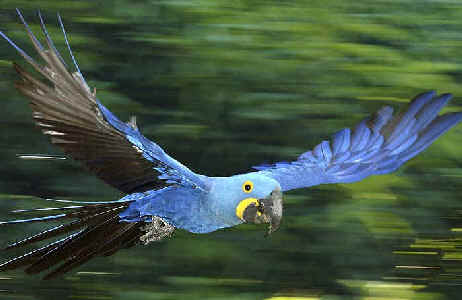
Above: As many as 40 Hyacinth Macaws
were seen well at one place during our March 2009 tour in Brazil.
Below: During another FONT tour in Brazil in 2009,
this White-eared Puffbird was photographed in Minas Gerais in October.
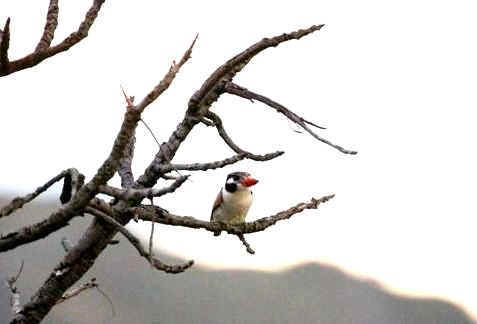
The tour summaries here are given with the most-recent tours first.
![]() For
some tours there are links below for longer NARRATIVES. Also there
are links to UPCOMING TOUR ITINERARIES, and LISTS relating to BIRDS,
MAMMALS, & OTHER NATURE.
For
some tours there are links below for longer NARRATIVES. Also there
are links to UPCOMING TOUR ITINERARIES, and LISTS relating to BIRDS,
MAMMALS, & OTHER NATURE.
Links to Tours:
CHILE
(November/December 2009)
BRAZIL
(& adjacent URUGUAY) (October 2009)
BRAZIL (southeast) (August 2009)
Japan (July 2009) (with a Total Solar Eclipse)
The CANARY ISLANDS (June 2009)
MEXICO
(March 2009) A Photographic Sampling from our March '09 tour in the
Yucatan
BRAZIL (& adjacent BOLIVIA) (March 2009) - during 1 tour: a
Jaguar, a Harpy Eagle at its nest, about 40 Hyacinth Macaws, &
nearly 400 Jabirus at one place
JAPAN, mostly HOKKAIDO (January/February 2009)
Northern MEXICO (SONORA) & Southern ARIZONA (January 2009)
GUATEMALA
(December 2008/January 2009)
![]()
Chile
- November/December 2009
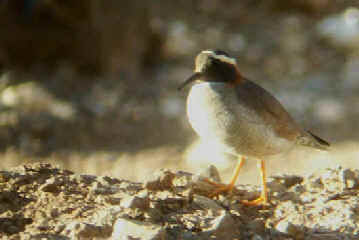
An extraordinary bird, the
Diademed Plover
was seen well
during the FONT Nov/Dec 2009 Chile Tour.
The first Focus On Nature tour ever was in Chile in
November 1990. 19 years
later, in 2009, from November 22 to December
4, we were there again. Chile was a
great destination for our first tour, and in 2009, it still was!
Our highlights in 2009 were many.
Probably foremost among them was a very close and cooperative Diademed
Plover.
When we saw that bird back in 1990, its English name was then the Diademed
Sandpiper-Plover. About 20 years later, in its preferred name, the
"sandpiper" had been dropped. But whatever its common name, that
absolutely striking bird of mostly the high Andes was as much of a thrill for us
to see in 2009 as it was two decades earlier.
Our 2009 tour was the 18th for FONT in Chile.
And, even so, we managed to enjoy a
spectacle, and a bird species that we had never previously seen.
Late one day,
with a backdrop of Andean mountains, and purplish-blue twilight sky, we watched
as about 500 Burrowing Parrots arrived at their roost for the night. Most flew
into their burrows. Some perched on snags on the big cliff that was the
dormitory for the birds. Rather like small macaws, the Burrowing Parrots were
so raucously noisy that evening across the gorge from us on the large cliff. Our
evening with them was another highlight of the
tour.
And yet more tour highlights were had during our time on Chiloe
Island in southern Chile. During a late-afternoon along the seacoast,
when the weather was absolutely beautiful (it is not always that way on
Chiloe Island), we enjoyed wonderful looks of both Humboldt and Magellanic
Penguins, a family of Kelp Geese, pairs of Fuegian (or Flightless)
Steamer Ducks, both Rock and Imperial Shags, a massive
swarm of shearwaters and other seabirds, and a mammal never
before seen during a FONT tour. That mammal is a counterpart in the Southern
Hemisphere of the Sea Otter in the North Pacific. Smaller than the Sea Otter, it
is called the Marine Otter, or locally, in Spanish, the "Nutria
del Mar" ("of the sea"). It is a rare animal.
Late that afternoon as we were leaving that wonderful seaside-spot, we saw
another animal that's rarely seen. A small and shy deer, called the Pudu,
it was standing still on the right side of a dirt road in front of our vehicle.
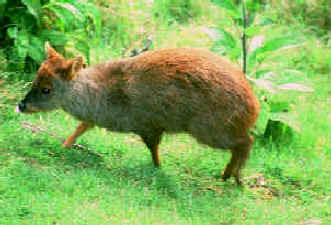
The small, shy Chilean
deer called the Pudu
The next morning,
further south on Chiloe, we walked along the
edge of a mudflat by a sheltered cove of the sea on the east side of the island.
It was a nice place that's certainly found to be so by Hudsonian Godwits
from North America. There were about 2,500 of them, by us, feeding tamely on the
flats.
And yet another highlight of our tour occurred the next day on Chiloe
Island. After we stopped our vehicle and got of it in the forest,
there was a nearby loud call followed by loud tapping. At eye-level very near
us, there were 2 female Magellanic Woodpeckers. We stood rather still,
and we were rather quiet. Another loud call was given, a short while later,
behind us, followed by a male Magellanic Woodpecker flying in, to also be
closely in front of us, at eye-level, and brilliantly seen in the
sunlight.

A female Magellanic Woodpecker
seen in the woods on Chiloe Island
during the November/December 2009 FONT Chile Tour>
This was 1 of 2 females along with a male
seen well at the same place.
(photograph by Robert Hinz)
Above, in capsule form,
have been some of the highlights of our 2009 FONT Chile Tour.
You may read more about these birds and mammals, and others, in the narrative
reached from the link below.
Links:
More
about the FONT Chile Tour in November/December 2009
List
of Birds & Other Wildlife during the FONT Chile Tour - November/December 2009
A
Complete List of the Birds of Chile (with
photos)
Mammals & Other Wildlife in Chile (with photos)
Upcoming FONT Birding & Nature Tours in Chile
![]()
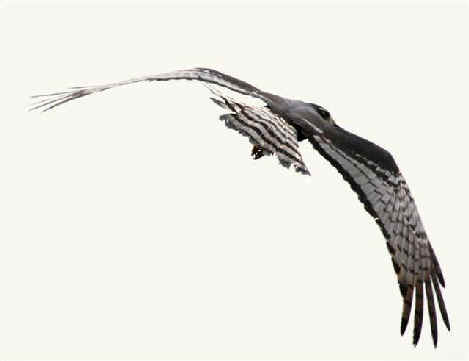
A Long-winged Harrier during
the FONT October 2009 Brazil Tour
in Rio Grande do Sul
(photo by Marie Gardner)
Brazil
(&
adjacent Uruguay)
- October 2009
When it was fall to the
north of the Equator, and spring to the south, we headed to where it was
springtime with birds singing, displaying, ands in their breeding attire.
We experienced our "second spring of 2009", from October 11 to 23, as
we did our 46th FONT
birding & nature tour in Brazil, and the first during which we ventured into
Uruguay (where we saw 23 species of birds on the grounds of an old fort, not too
far from the coast).
In Brazil, we were in the states of Minas Gerais and
Rio Grande do Sul. The
second of these is the southernmost Brazilian state, with the character of
nearby Argentina & Uruguay. And with birds more in tune with those
more-southerly countries, such as: Coscoroba & Black-necked
Swans, and
waterbirds including 3 species of coots and ducks such as the
Red Shoveler, and
landbirds such as the Warbling Doradito and Spectacled Tyrant.
Some notable birds during our October '09 tour included the localized
hummingbird known as the Hyacinth Visorbearer, the rare flycatcher
named the
Black-and-white Monjita, and the large raptor called the Black-chested
Buzzard-Eagle.
We saw 8 species of terns in one area, with probably the best for us being the
Snowy-crowned, or Trudeau's, Tern. Also in that one area, we saw 4 species of
gulls, with the rarest being the Olrog's, formerly part of the Band-tailed,
Gull.
During our two-week dip into the South American spring, we enjoyed birds that
ranged from a penguin to parrots. Also, a motmot & manakins and much more in
the realm of birds (we found nearly 300 species), while other nature during the
tour included monkeys & marmosets, and 2 nights with the Maned
Wolf.
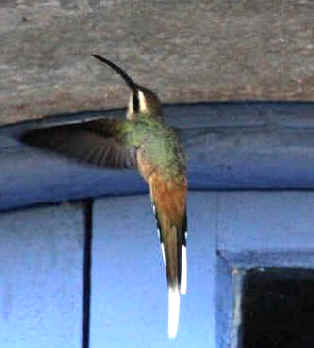
Two of the hummingbirds
during our October '09 tour in Brazil.
Above: a Planalto Hermit getting a breakfast of bugs
at a wall of an old monastery, and
Below: a Hyacinth Visorbearer with color
even on a rainy, cloudy morning.

Links:
List of Birds & Other Wildlife during the FONT Brazil Tour - October 2009
A Photographic Sampling from our October 2009 Brazil Tour
A
Complete List of the Birds of Brazil (with some photos):
Part #1: Tinamous to Doves
Part #2: Macaws to Flycatchers
Part #3: Antshrikes to Grosbeaks
Birds during FONT tours in Minas Gerais
Birds of Rio Grande do Sul & adjacent Uruguay
Rare Birds during FONT Tours in Brazil (with some photos)
Mammals & Other Wildlife in Brazil (with some photos)
Upcoming FONT Birding & Nature Tours in Brazil
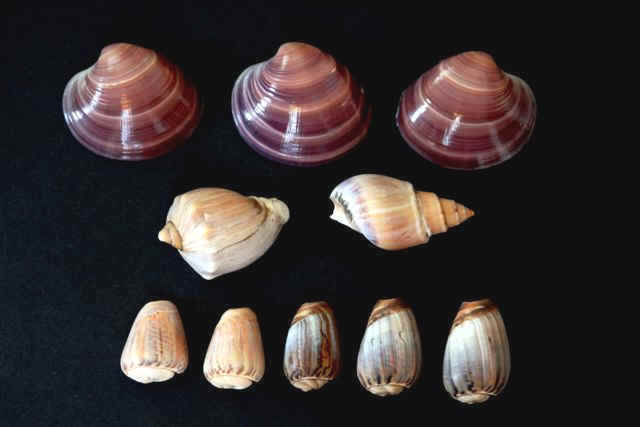
Shells from the beach in Rio
Grande do Sul,
in far-southern Brazil,
where during the FONT tour in October 2009,
there were 8 species of terns and Magellanic Penguin.
![]()
Brazil
(southeast) - August 2009
From August 16 to
24, 2009, we did our 45th FONT birding & nature tour
in Brazil.
It was in the southeastern part of the country, along the seacoast
and in the mountains. Much of our birding in those areas, and in between, was in
the Atlantic Forest - an arc of native forest mostly in Brazil, with a number of
birds, animals, and plants, either endemic to southeastern Brazil or nearly so.
Birds, in those categories, that were particularly notable included tanagers and
hummingbirds.
Many of those birds and others during the tour were colorful indeed with various
hues of blues, greens, yellows, and more. In addition to about 20 species of
tanagers, other bright, colorful birds included euphonias, chlorophonia, dacnis,
and honeycreeper.
The male of one of the tanagers was mostly bright red - the Brazilian
Tanager,
with the local name in Portuguese of "Sangue do Boi", which translated
means "blood of the bull".
Just as red were the Scarlet Ibises that we saw at a coastal lagoon. What a
bright flock they were as they fed in the shallow water by our boat!
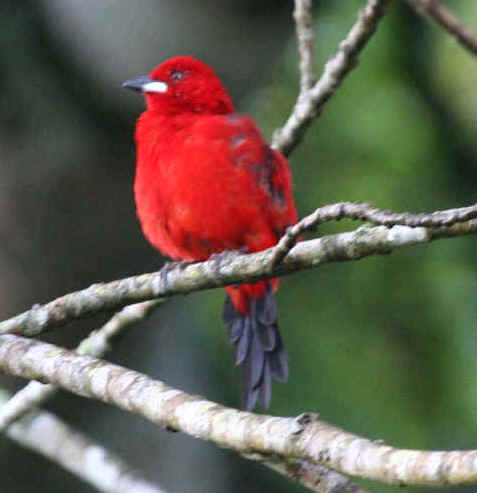
Brazilian Tanager
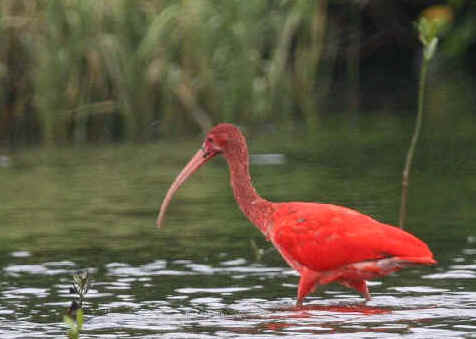
Scarlet Ibis
Also among the colorful birds that we saw were
toucans and toucanets. Even a
change of an English still relates to colors: what has been called the
Red-breasted Toucan is now known as the Green-billed Toucan. (And of course, red
& green are not its only colors.)
Other notable birds included a couple species of Herons: the Capped and the
Whistling. And a couple species of Hawks: the White-necked and the
Mantled. Both
of those raptors are restricted to southeast Brazil.
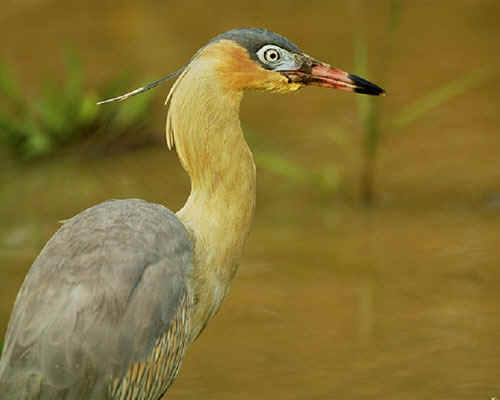
Whistling Heron
The Robust Woodpecker that we saw at its hole in a tree by the parking lot where
we stayed is in the same genus as one formerly in North America - the
Ivory-billed Woodpecker, a bird no longer seen going in and out of any hole in a
tree.
Among the woodcreepers we saw, one species was especially interesting. Some
Plain-winged Woodcreepers were traveling in the forest with a group of monkeys -
Black Tufted Capuchins. Something about those monkeys was attractive to the
woodcreepers, as they went up & down the trees beneath them.
Two species of our flycatchers, during the tour, had long tails - one, aptly
named the Long-tailed Tyrant, that we saw one place after another, and another
that we saw only once, the Streamer-tailed Tyrant. The second of these has
always been for us a wonderful bird to see, being an attractive bird, mostly
gray with some burgundy.
But, as noted, it was the tanagers and hummingbirds that this time for us were
the avian stars of the tour. Being so close to them and their frenzy of
activity, at the places we visited
with feeders, was, more than once, an experience to be savored - and it was!
Prior to this tour, our cumulative tally of birds in Southeast Brazil was 491
species. 5 "new ones" were added in August '09 to that list.
Maybe the best was Green-and-rufous Kingfisher that we saw closely and well as
we were standing on a bridge. But also nice were the other 4: the Gray Hawk,
Large-billed Tern, Nacunda Nighthawk, and Sooty-fronted Spinetail.
In all, 228 species of birds were found during our Southeast Brazil Tour in
August 2009.
Links:
List of Birds & Other Wildlife during the FONT Brazil Tour - August 2009
A
Complete List of the Birds of Brazil:
Part
1: Tinamous to Flycatchers
Part 2: Antshrikes to Grosbeaks
Birds in Southeast Brazil (with some photos)
Rare Birds during FONT Tours in Brazil (with some photos)
Mammals & Other Wildlife in Brazil (with some photos)
Upcoming FONT Birding & Nature Tours in Brazil
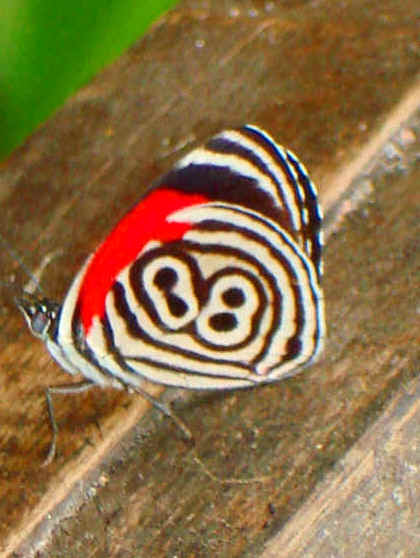
An " Eighty-eight
Butterfly", Diaethria clymena,
photographed during the August 2009 FONT tour in southeast Brazil
(this & the following 2 photos by Tom Ludes)
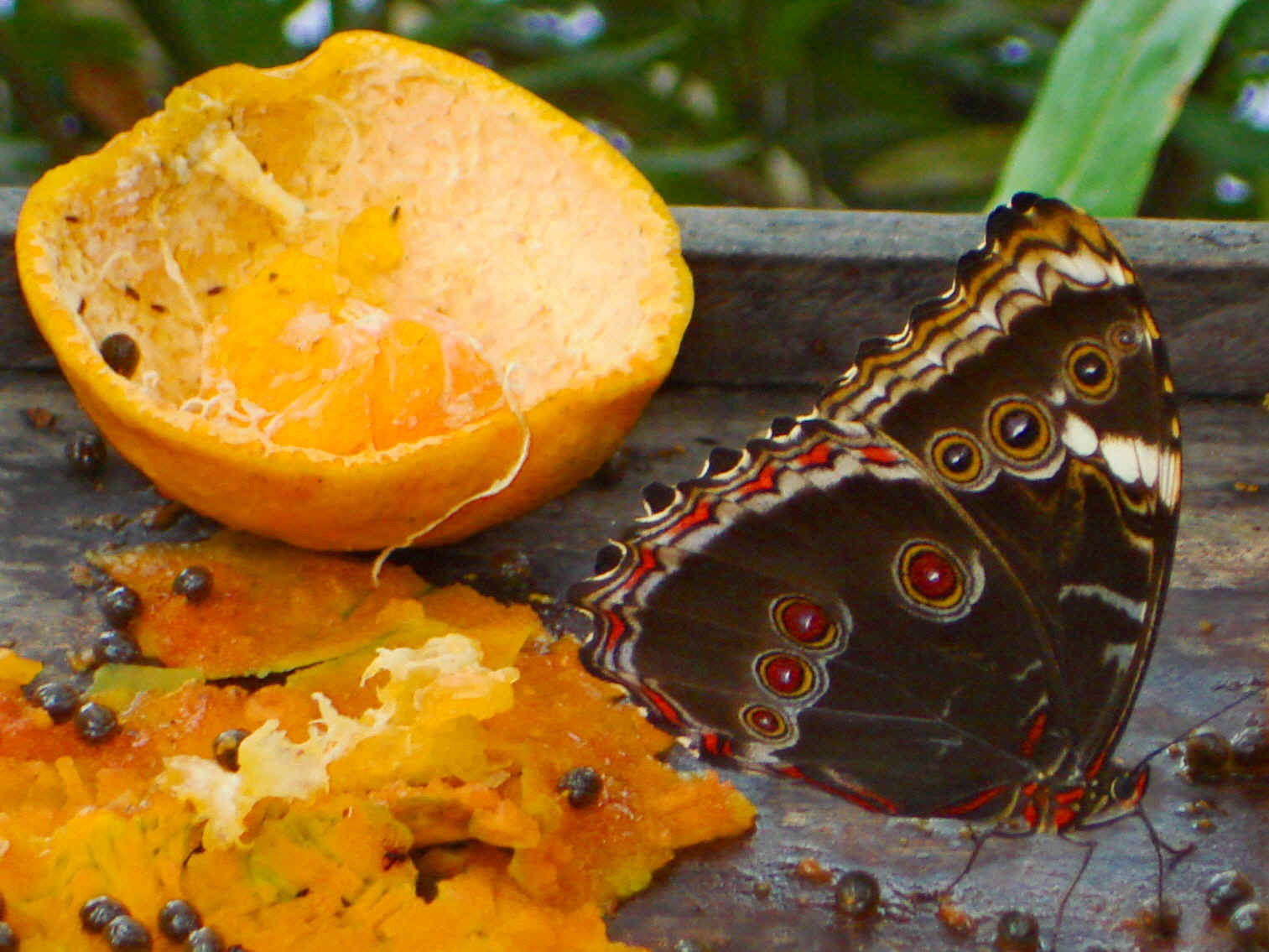
A Morpho Butterfly, having
just feasted on a mango,
also photographed in southeast Brazil during the August 2009 FONT tour.
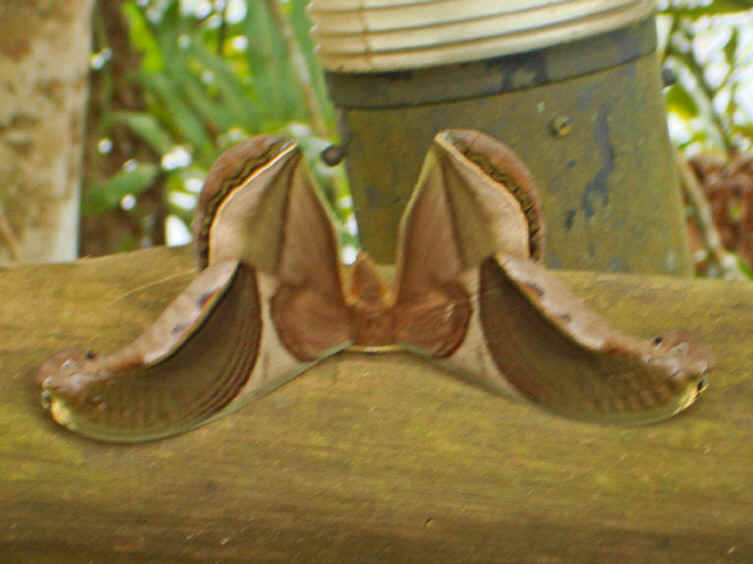
A large moth, on a wooden
fence,
during the day
This unusual creature was also photographed
during the August 2009 FONT Southeast Brazil tour.
![]()
It took place during the Summer of 2009, specifically July 12-26. It was the 32nd FONT birding & nature tour in Japan, and the 8th FONT tour, since 1991, with an eclipse of the Sun. It was our 5th tour with a total solar eclipse.
Previous total solar eclipses during FONT tours were in:
Costa Rica in July
1991,
Bolivia in November
1994,
Venezuela in February
1998,
and Turkey in August
1999.
We've seen annular solar eclipses during our tours in Iceland
in May 2003 and in Spain
in October 2005.
A partial solar eclipse took place during a FONT tour in Guatemala
in April 2005.
At the north end of
the southern Japanese island of Amami, we
experienced the total eclipse of the Sun on July
22, 2009. Our vantage point was at the tip of a cape by the Pacific
Ocean. During the eclipse, some of the people in our group took a dip in the
nearby ocean water, as overhead the disk of the Sun could be seen shrinking and the sky's
light was fading.
The Sun, at the totality of the eclipse, was high in the sky. The nearly 4
minutes of totality, where we were, was at about 11:00am.
Unfortunately, also in the sky above us were clouds. There was a thin layer of
them during most of the eclipse prior to totality, as well as during the nearly
4 minutes when darkness fell.
So, even though we could not see some of the features of a total eclipse that we
would have if the sky were cloudless, there certainly was an experience to be
had.
To the north of us, where totality was longer, we learned later that the clouds
were thicker (so thick that the eclipse overhead in the sky could not be seen at
all). Along the center line, to our north, totality was about 2 minutes
longer, making it just over 6 minutes, and giving this eclipse the longest
period of totality of any during the entire 21st Century.
During the nearly 4 minutes of darkness where we were, there was a fascinating
pattern of clouds in our sky. Truly ominous they appeared. A short distance
away, during the mid-day darkness, the beacon of a lighthouse on rocks above the
sea shone as it would at night.
The Pacific Swallows, by the Pacific
Ocean, during dark totality stopped flying. They actively flew about us during
most of the eclipse. A Pacific Reef Heron flew along the water's edge of
the Pacific, also during the eclipse, as did some Roseate Terns.
Overall, birds that day at that cape at the north end of Amami Island were not
plentiful, but people were. Nicely, though, it was not crowded where we were, at our
good vantage point, but as we looked about, especially behind us, we could see that
we were but a few of the many who had come to experience the event. Mostly,
those who came were Japanese.
It was the first total solar eclipse in Japan in many years, and so considerable
publicity and anticipation preceded it. From the heavily populated Japanese
islands to the north, many came to the relatively small, and usually not often
visited, Amami Island, coming over a period of days by plane or by ferry. (We
did the latter, from Okinawa.)
They filled the few hotels on Amami, but many who came for the eclipse camped in
tents at the north end of the island. We spent our nights on Amami in hotels (2
of them), but when we looked to our right, from our vantage point, we saw
many of the tents in the dark shadow of the eclipse. Turning to our left, we saw
the open water of the Pacific Ocean, while overhead there was, that morning, the
sun, the moon in front of it, and the clouds.
During our minutes of totality, to the south there was a brighter sky toward the
horizon, where a few miles away, in that direction, the shadow of totality did not occur.
Just about 2 hours after the eclipse, as we were going south from the totality
zone toward town (to Naze, the largest city, and actually the only city on
Amami), rain poured down from the clouds that by then had thickened. Earlier
that day, by comparison, we had been fortunate to have had the eclipse
experience that we did.
The Japanese island of Amami, with or
without an eclipse, is a wonderful place. We've visited it many times, with over
15 FONT tours there. With mostly forested hills, it's a "green island"
with some wildlife nearly all its own. There are birds endemic to the island or nearly so.
During our July 2009 tour, birds in those categories that we were treated to
included the colorful Lidth's Jay, the nocturnal Amami Woodcock,
and the very rare Amami Thrush.
In all, 139 species of birds have cumulatively been found during FONT tours in
Amami. In July '09, we added 5 to that list: Cinnamon Bittern, Ruddy-breasted
Crake, Watercock, Black-winged Stilt, and Wood Sandpiper. They were
all found during an enjoyable couple morning hours in an area of fields and rice
paddies.
The Black-necked Stilt is a rarity in Amami.
The Watercock was not only new for us in Amami - it was a new bird for
FONT tours in Japan, bringing the cumulative tally of birds in Japan during FONT
tours to 390 species.
Other notable birds during our July 2009 Japan tour included the extremely rare Okinawa
Woodpecker, the Okinawa Rail (that became known to science
only as recently as 1982), Black-naped Terns, and a Terek
Sandpiper.
Our views of Ruddy Kingfishers were sometimes brief, but we always liked
hearing their distinctive, rollicking calls, as we did frequently.
In addition to the birds that we either heard or saw during our tour in Japan in
July 2009, we also enjoyed a tremendous number and variety of butterflies and dragonflies.
And there were some mammals too - including Wild Boar, Sika Deer, and a
quick glimpse of the odd nocturnal creature known as the Amami Rabbit.
It's endemic to that island.
With the eclipse, the variety of nature, and the native culture and cuisine of
that out-of-the-way part of Japan, our July '09 tour in Okinawa,
Amami, Kyushu, and a bit of Honshu,
was a memorable one.
Links:
More
about the FONT Japan Tour in July 2009
Birds & Other Wildlife during the FONT Japan Tour - July 2009
Cumulative List of Birds during FONT Japan Tours (with photos)
Rare Birds during FONT Tours in Japan
Butterflies of Japan (with photos)
Upcoming
FONT Japan Birding & Nature Tours
Solar Eclipses & Other
Celestial Nature during FONT Tours
![]()
This tour, in the fascinating Canary
Islands, in the Atlantic Ocean, off the northwest coast of Africa,
followed our June 2009 tour in Spain. Although
closer to Africa than Europe, the Canary Islands are actually part of Spain.
We visited 3 of the islands, each quite different than the others. Each has its
own character.
And on each we saw birds not found on the others.
The 3 islands, during the tour, were:
Lanzarote, truly fascinating, with the most
remnants of volcanic activity, and mostly arid. At the north end of that island,
we visited an area of tremendous cliffs by the sea, where seabirds nest
and where the Eleonora's Falcon flies.
Fuerteventura, the closest of the Canary
Islands to Africa, and where the terrain and some birds are those of that
continent. Among those "African birds", the Cream-colored Courser
was a favorite of ours. We had close looks at 2 adults and 2 of their
nearly-grown young.
Tenerife, further west, and an island much
more green, with coastline (of course), and forests, fields, hills, and a
mountain as high as about 12,000 feet above sea-level. While the island is more
"green", a favorite bird of ours on this island was "blue" -
the beautiful blue of the endemic Blue Chaffinch.
During this tour in the Canaries, we saw all of the 2-dozen plus endemic and
specialty birds that we sought, including such "goodies" as the Houbara
Bustard, the Barbary Falcon, the rare & localized Canary
Islands Bush Chat, and, yes, the Canary (the wild Canary
indigenous to the Canaries).
Mammals, during the tour, included the Algerian Hedgehog and the Canary
Shrew.
Click the link above to read more, and to find a list, with notes, of the
species found.
Links:
More about the FONT
Canary Islands Tour in June 2009
List of Birds & Other Nature during the FONT tour in the Canary Islands - June 2009
Cumulative Lists of Birds & Other Wildlife of the Canary Islands
Cumulative Lists of Birds & Other Wildlife during FONT Tours in Spain & the Canary Islands
Upcoming FONT Birding & Nature Tours in Europe
![]()
During this, the 25th FONT birding
& nature tour in Spain, and our 52nd
tour in Europe, we visited some wonderful places, where we saw some fine birds
and animals.
As many as 215 species of birds were found during the FONT Spain Tours in June
2009. 28 of those species were only during the extension tour in the Canary
Islands (a part of Spain) in the Atlantic Ocean. And
thus, 187 species of birds were found during our nearly 2-week tour in mainland
Spain.
Outstanding among a nice number of mammals was a particularly nice large male
Red Deer, and some Spanish Ibex high on rock cliffs above us in the
mountains.
Regions that we visited were mostly in central Spain, from Extremadura
(near the Portuguese border) to the Ebro Delta
(along the Mediterranean coast in Catalunya).
In between, places included the Gredos Mountains
and the wetland known as Las Tablas de Daimiel in
Castilla-La Mancha.
Birds that we found ranged from as big as the Great Bustard to as small
as the Little Bittern and Little Grebe, and smaller yet, to the Goldcrest
(the littlest of European birds).
Among our larger birds, some were exceptionally notable, including the Cinereous
Vulture, a rare bird with the largest wingspan of all European raptors (we
saw over 20 during 1 afternoon!), the Spanish Imperial Eagle, the Eagle
Owl (the largest European owl), and both Black Storks
and White Storks (we saw thousands of the latter).
Among the colorful birds that we were treated to there were these: European
Bee-eater (we saw many), European Roller, Common Kingfisher,
and the Eurasian Golden Oriole. Not with coloring as bright, but
certainly a bird great to see, each time that we saw it, was the Eurasian
Hoopoe.
Notable among the waterbirds that we saw were White-headed Duck (a
couple dozen), and 3 species of Gulls, among others: the rare Audouin's,
the attractive Slender-billed, and a very nice Mediterranean in
full breeding plumage.
Always nice, either by castles, churches, city walls, and other old stone
structures were the fore-mentioned White Storks, along with flying Lesser
Kestrels, Common Swifts, Western Jackdaws, and Eurasian Crag Martins.
Such birds and settings are truly the essence of
Spain.
Links:
List of Birds & Other Wildlife during our Spain Tour - June 2009
Cumulative List of Birds during our Spain Tours
Upcoming FONT Birding & Nature Tours in Europe
![]()
During the second week of June
in 2009, this was the 16th FONT tour on the island known as Iceland,
the fourth largest island in the Atlantic Ocean and truly a wonderful place to
see & experience a varied assortment of nature. Only on this island is the
geological phenomenon called the Mid-Atlantic Rift to be seen, as we saw
it, above the water of the ocean.
Throughout the island, with its magnificent scenery, there's fascinating geology
and topography with lava fields, volcanoes, waterfalls, glaciers, and a geyser
or two. Whether it was when we were along the seacoast, or in the interior, the
countryside was, for us on the tour, like being, simply put, in
"another world".
And in those varied places that we visited there were always birds. Our
"favorite" was the Puffin. From the front of a boat, we were
close enough to be nearly "eye to eye" with those
"parrot-headed" little seabirds on the top of a small island, as they
popped out of their burrows, shook their wings, and then looked just-plain
"cute"! Everyone liked the Puffins! It could not have been
otherwise.
Other birds also were enjoyed during the tour, as we observed either from our
vehicle, or walking about, or looking from a boat - birds such as: the Ptarmigan
that we saw well, the 2 White-tailed Eagles (an adult and a juvenile),
the greenish-hued Shags with their young (so very little!), the
flocks of gaudy Harlequin Ducks, the bold Great Skuas, their
cousin the Parasitic Jaeger, and the shorebirds (or waders)
at their nesting sites, including : the brightly-colored Black-tailed
Godwit, the European Golden Plover, with its plaintive call, the Whimbrels
with their melodious song given in flight, and of course the master of these
birds with a flight display, the Snipe.
We saw overall hundreds, probably a few thousand, Common Eider - a treat
to see. But a special treat was a single male King Eider!
As participants wrote at the end of the June 2009 Iceland tour: In addition to
the birds, we liked so much "the pastoral countryside, with picturesque
farms and churches, along with Icelandic
horses, sheep and lambs, white swans in green pastures, beautiful and
delicate wildflowers, and so many configurations of lava". Just as we
liked "our Icelandic dinner of leek soup, cod with sauce, and a rhubarb
dessert" and our good times throughout the tour with "our gregarious
and happy
group".
Links:
More about the FONT Iceland
Tour in June 2009
List of Birds during our Iceland Tour - June 2009
Birds during previous FONT Iceland Tours (with photos)
Complete
Iceland Bird-List
(over
350 species, including vagrants from mainland Europe, Asia, & North America)
Upcoming FONT Birding & Nature Tours in Iceland
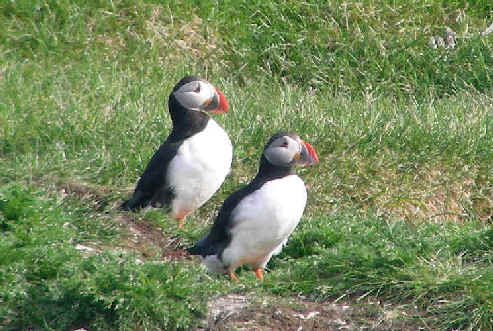
These Atlantic Puffins were
photographed
during the FONT tour in Iceland in June 2009.
(photo courtesy of Gerin Hood)
![]()
During this tour, we found the birds that we sought. Among the over 100 species
of birds, during this landbirding & nature tour in eastern North
Carolina, those sought-species included:
the Swainson's Warbler and some others in that tribe, the Red-cockaded
Woodpecker, the Bachman's (or "Pinewoods")
Sparrow, and the Painted Bunting.
Other notables included Wilson's Plover, Mississippi Kite,
Chuck-will's-widow, Red-headed
Woodpecker, Brown-headed Nuthatch, Prothonotary Warbler, and Summer Tanager.
Unexpected birds that we saw included a Loggerhead Shrike, and a dozen or more
Cliff Swallows to seemed about to nest on a ferry boat that crosses a river
(continuously during the day) in south-central North Carolina, not far from the
seacoast. According to most books, that species really is not to be expected
there - during the breeding
season.
Birds that we saw along the seacoast that were particularly nice were flocks of White Ibises, and a
single flock of Red Knots that stopped to feed during their long journey
from far-southern South America to the tundra almost as far north as birds can
go in far-northern North America.
Not going very far, from where we saw them, was some other wildlife that we saw
during the tour: an Eastern Fox Squirrel with its white nose, and a Cottonmouth
snake, with its white mouth
wide-open.
Links:
List
of Birds & Other Wildlife during our North Carolina Tour in May 2009
List of Birds during Previous North Carolina
Tours
Lists of Mammals (Land & Sea) during
Previous North Carolina Tours
Selected List of Butterflies, Dragonflies, & Damselflies in North Carolina
Selected List of North Carolina Reptiles & Amphibians
Upcoming North Carolina Tour Itineraries
![]()
Guatemala - April/May 2009
During this, the 16th FONT tour in Guatemala, we visited both the highlands and
lowlands of the country. We saw much, in that picturesque and interesting land,
including 16 species of hummingbirds, and 280 species of birds in all.
Among them there were motmots, and manakins, orioles and oropendolas, wrens and
warblers, and tanagers, trogons, toucans, toucanets, thrushes, and
tityras.
Among the mammals, there were a couple beginning with the letter "t":
a tapir and a tayra.
Maybe most notable among our birds was a pair of very rare Azure-rumped
Tanagers. We saw them so very nicely!
Two other bird species were seen with "Azure" in their names: both
actually with the same adjective, the Azure-crowned Jay and the Azure-crowned
Hummingbird.
Among our smaller hummingbirds were the Black-crested Coquette and the
Emerald-chinned Hummingbird; among our larger ones, there were 3 species of Sabrewings: the Violet, Rufous, and Wedge-tailed.
Among our Woodcreepers, there was the Wedge-billed, while among our
Woodpeckers,
there was the Pale-billed (rather like the infamous, and now probably
extinct,
Ivory-billed Woodpecker of North America - it's in the same genus.)
Among our Warblers, a good one indeed was the Pink-headed. We viewed well that
wonderful bird.
And among our many other birds also viewed well are 2 others deserving mention
here: Long-tailed Manakins as they performed on a forest branch, and a
Leaftosser doing just that, tossing leaves, on a forest floor, just a few feet
from us!
As during our previous Guatemala tours, again we saw Orange-breasted Falcon by a
Mayan temple. We've always enjoyed our tours in Guatemala, and in April/May 2009 we
did so again.
Links:
Lists of Birds & Other Wildlife during our Guatemala Tour in April-May 2009
Cumulative List of Birds during FONT tours in Guatemala
Upcoming FONT Birding & Nature Tours in Central America
![]()
Colorado (& adjacent
states) - April 2009
(the
adjacent states were Kansas, Oklahoma, New Mexico, & Wyoming)
This tour, during the
second week of April in 2009, was a slightly
abbreviated version, that ended a day or so early due to a large mid-spring
snowstorm in the Rocky Mountains. (None of us wanted our trip home to be
delayed.)
But what we did of the tour, in Colorado and nearby
Kansas, Oklahoma, and Wyoming, was wonderful!
We particularly enjoyed an early-morning with about 50 Greater Prairie
Chickens performing their displays and antics, close and all around us. The
displaying Greater Sage Grouse were also a treat.
Other birds that were treats included Mountain Plover (seen well) and
Sage Thrashers (singing atop bushes in brilliant late-afternoon
sunlight).
A special treat was one morning (as the snowstorm was about to begin, but
when the sun still shone through the clouds) when, at a place with bird
feeders in the mountain forest, there were hundreds, and maybe a thousand or so,
"northern finches". There were hundreds of Pine Siskins,
including a swarm of them feeding on seeds on the ground. There were dozens of Pine
Grosbeaks, including a number of them like ornaments in coniferous trees.
And, along with the siskins and grosbeaks, there were also nice
numbers of Cassin's Finches and Rosy Finches. Among the latter,
most were the Brown-capped Rosy Finch (a Colorado near-endemic), but
also there was the Black Rosy Finch (that does not breed in the state)
.
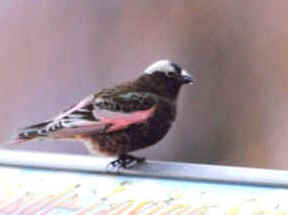
A Black Rosy Finch photographed during the
FONT tour in Colorado
in April 2009
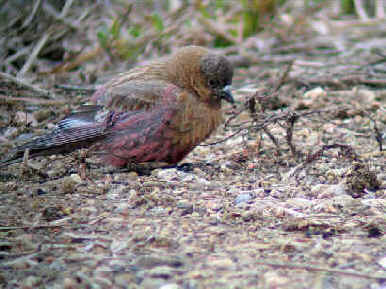
The
Brown-capped Rosy Finch was one of birds sought
and nicely seen during the FONT April 2009 tour in Colorado.
Nearly 20 species of mammals were seen ranging in size from the Least
Chipmunk to the Moose. Among those in between, highlights included a Badger
that ran in front of us, and an all-black Abert's (or Tassel-eared)
Squirrel.
Colorado is a wonderful state in which to enjoy nature, but we also had good
times in Oklahoma and Wyoming.
In Oklahoma, we ventured one day as far west as one can, to the New Mexico
border, in the narrow "no man's land", where still nearly no men (nor
women) live. Among the birds for us there, a Golden Eagle flew
closely by.
Actually, and oddly, the most western bird that we saw in Oklahoma was the Eastern
Phoebe (a pair).
In Wyoming, our birds included another Golden Eagle, Rough-legged Hawk,
and a plethora of ducks of various sorts.
Lastly, to be noted here, back in Colorado, 4 sorts of juncos were
seen at 1 place, all Dark-eyed: the "Oregon",
"Pink-sided", "Gray-headed", and "Slate-colored".
Juncos, as you may know, are sometimes called "Snowbirds".
As to that snow, about 2 feet occurred in parts of the Denver area, and as much
as 6 feet fell in the high mountains.
In addition to the
birds and animals just noted, the wonderful scenery and interesting history,
along the way, as we traveled about, added to our overall experience, which was
made all the better by the good comradeship of those on the tour.
The dates for this tour in 2009 were April 10-16.
Links:
Birds & Other Wildlife during our Colorado Tour in April 2009
Birds & Other Wildlife during previous FONT Colorado Tours in April
Birds
during FONT Tours in Colorado & nearby states (with photos)
A
Feature - the Grouse of Colorado & Kansas
Mammals during FONT tours in Colorado & nearby states (with photos)
Upcoming
FONT Birding & Nature Tours in Colorado & nearby States
![]()
Mexico
(mostly the Yucatan; also Cozumel Island)
- March 2009
This was the third
FONT tour in the Yucatan region of Mexico in less than a year. The previous two
were in June & November of 2008.
Each of these tours were actually quite different, in terms of the seasons and
the birds & other nature found. March was much drier than either June or
November. There was less song, by the resident birds, in March than there had
been in June. And, of course, both in November &
March, the bird population
was augmented by migrants that breed in North America. Those in our group, who
wouldn't normally see many warblers in the summer where they live, were
certainly treated to many of those colorful birds during the tour. One person
tallied 50 during a very short roadside walk in mangrove and scrub habitat, with
all at his eye-level or lower. Many were Northern Parulas, with not one of them
giving the "warbler neck" a birder can often get when observing that
small species high in a tree!
Some birds were seen during the March 2009
tour that were not found previously in
June & November '08. Especially notable among them were Pinnated Bittern and
King Vulture. Both were seen well, in a scope, by everyone in the group.
Two notable hummingbirds were seen during the tour: the beautiful Cozumel
Emerald (endemic to the offshore island of Cozumel) and the Mexican Sheartail
(a rare bird also with a limited range, in the Yucatan along the coast). During the month of
March, as to the Sheartail, we were able to see not only the distinctive male,
but also a female on the nest - as well as another nest in which there were some
very tiny eggs.
In all, 245 species of birds, of a fine mix, were found during our March 2009
Mexico Tour. (Click the link above for the complete list.)
And the mammals & other wildlife, during the tour, were good too - actually
more than good because once again, as during our November 2008 tour, A JAGUAR
WAS SEEN - as it was on a road at night, in a forested area of southern
Mexico!
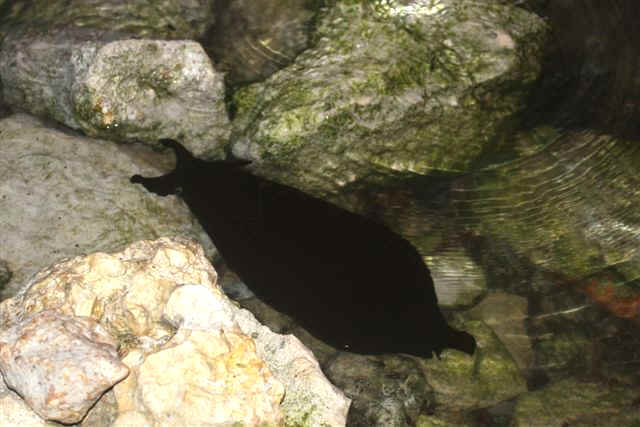
This odd creature was seen
in the water of a coastal bay
from the shoreline in the northern
Yucatan,
after dark, during the FONT Mexico tour in March 2009.
In English, it's called the Atlantic Black Sea Hare.
Its scientific name is Aplysia morio.
In Spanish, it's a "Tinta", so called because it ejects ink when
disturbed.
The word "tinta" in Spanish means "ink".
The creature, 16 inches long, and 14 inches across,
is in the Phylum Mollusca (the Molluscs),
and in the Class Bivalva (Bivalves) as are other things such as
the Common Periwinkle, the Slipper Limpet, and the Green Ormer.
The Sea Hare swims in the direction of its "two-pronged head",
in other words, toward the upper left of the
photo.
(photo by Marie Gardner)
Links:
Lists of Birds & Other Wildlife during our Mexico Tour in March 2009
List
of Birds of the Yucatan Region of Mexico (with photos)
A Photographic Sampling of Nature
& Culture during our March '09 Tour in the Yucatan of Mexico
Upcoming FONT Birding & Nature Tours in Mexico & Central America
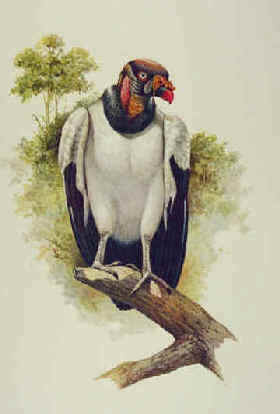
An adult King Vulture was one
of the highlights of our March 2008 tour in southern Mexico.
When it was perched on a large tree branch, everyone observed it through a
scope.
Later, at the end of the tour, when the 10 participants voted for their
"top birds", it was Number #1.
At the end this 10-day tour, the participants voted for their "top 10 birds", and following below is the composite-list of that vote. 10 people voted, and 43 birds received votes, out of the 245 species found during the tour.
1 - KING VULTURE
2 - Mexican Sheartail
3 - Ferruginous Pygmy Owl
4 - Pinnated Bittern
5 - American Pygmy Kingfisher
6 - Yucatan Jay
7 - Bat Falcon
8 - American Flamingo
9 - Red-crowned Ant Tanager
10 - Ocellated Turkey
11 - Yucatan (or Black-throated) Bobwhite
12 - Gartered (or "Violaceous") Trogon
13 - Lesser Roadrunner
14 - Black-headed Trogon
15 - Keel-billed Toucan
16 - Cozumel Vireo
17 - Squirrel Cuckoo
18 - Pale-billed Woodpecker
19 - Blue Bunting
20 - Painted Bunting
21 - Crane Hawk
22 - Laughing Falcon
23 - Gray-throated Chat
24 - White-tailed Kite
25 - Bare-throated Tiger Heron
26 - Wilson's Plover
27 - Cozumel Emerald
28 - Rufous-browed Peppershrike
29 - Red-throated Ant Tanager
30 - Eye-ringed Flatbill
31 - "Golden" Yellow Warbler
32 - Hooded Warbler
33 - American Redstart
34 - Black Catbird
35 - Crimson-collared Tanager
36 - Barred Antshrike
37 - Dusky Antbird
38 - Yucatan Wren
39 - Black-bellied Whistling Duck
40 - Black-cowled Oriole
41 - Orchard Oriole
42 - Great Black Hawk
43 - Ridgway's Rough-winged Swallow
The last of these was actually the last of the birds to be found during the
tour. A pair, that appeared to be quite territorial, was found on a projecting
ornament up near the ceiling INSIDE a shopping mall at Tulum, as we stopped for
a snack and some gift and souvenir shopping on the way to the hotel by the
airport!
![]()
Brazil (&
adjacent Bolivia)
- March 2009
This was the 44th
FONT birding & nature tour in Brazil, during which there were some tremendous
highlights, among them a Jaguar (1 of 3 species of wild cats during
one night's excursion), a Harpy Eagle on a nest, as many as 40
Hyacinth Macaws seen closely, and nearly 400 Jabirus at one place - on an island
in a river. Over 300 of the big, tall Jabirus were standing or walking about on
short grass. The others were soaring about on thermals in the sky above. This
tour also included a sojourn into neighboring Bolivia.
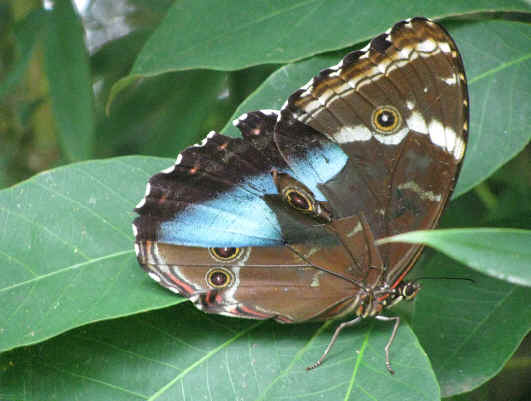
When this Morpho Butterfly
(Morpho achilles) opens its wings and flies,
it is a most brilliant blue.
This photograph was taken during the FONT birding & nature tour
in Mato Grosso, Brazil in March 2009.
(Photo by Patricia
Yoder.)
Links:
List of Birds & Other Wildlife during the FONT Brazil Tour - March 2009
A
Complete List of the Birds of Brazil:
Part
1: Tinamous to Flycatchers
Part 2: Antshrikes to Grosbeaks
Birds in Mato Grosso do Sul (with photos)
Birds in Southeast Brazil (with photos)
Rare Birds during FONT Tours in Brazil (with photos)
Mammals & Other Wildlife in Brazil (with photos)
Upcoming FONT Birding & Nature Tours in Brazil
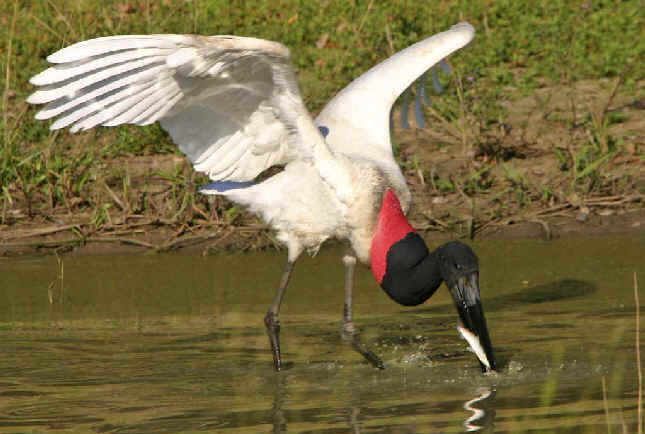
![]()
Japan
(mostly Hokkaido & some Honshu) - January/February
2009
This was the 31st FONT birding & nature tour in
Japan. It was an abbreviated version of what we've done over the years, with
what would well be called "the best of Japan in the winter". The tour
was mostly on the northern Japanese island of Hokkaido, with also some birding
on the main Japanese island of Honshu.
Highlights of the tour, as they have been
in the past, were: groups of Japanese, or Red-crowned Cranes, dancing and
calling on snowy fields, and numbers of both White-tailed and Steller's Sea
Eagles. And again, as always (for us), we saw the Blakiston's Fish Owl, said to
be the largest and about the rarest owl in the world.
The upcoming FONT Winter Tour in January 2010 will again be the longer tour, on
the islands of Honshu, Hokkaido, and Kyushu, with an optional extension to the
more-southerly island of Amami for endemic & specialty birds.
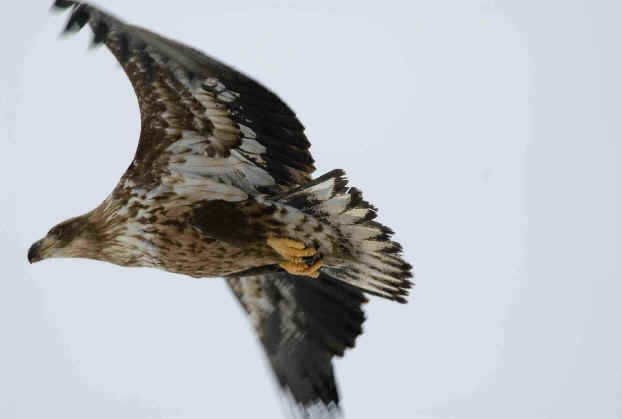
This immature White-tailed
Eagle was photographed in February 2009
during the annual FONT Winter Birding & Nature Tour in Japan.
Some other photos of birds during that tour are below.
(photos by Karl Frafjord)
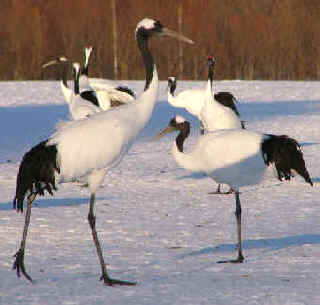
The word in Japanese for the Crane is "Tancho".
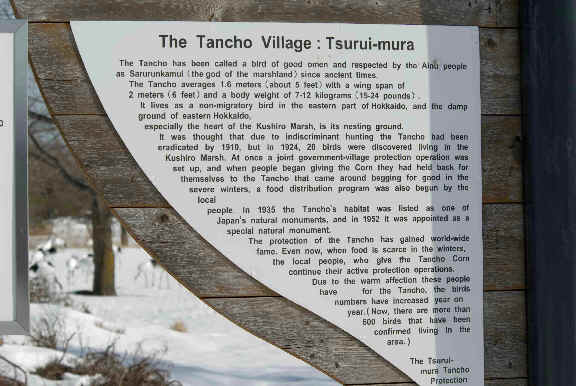
Links:
Birds & Other Wildlife during FONT Japan Tour in January-February 2009
Cumulative List of Birds during our Japan Tours
Rare Birds during FONT Tours in Japan
Upcoming FONT Japan Birding & Nature Tours
The following account was written by Armas Hill, leader of the tour:
Of course, during
our winter tours in Japan, particularly in Hokkaido,
birds that are highlights are those such as the dancing and calling Red-crowned,
or Japanese, Cranes, the gatherings of Steller's and White-tailed
Eagles, the flocks of Whooper Swans, and the large & rare
Blakiston's Fish Owl.
All of those we experienced again during our Jan/Feb
2009 Japan Tour in Hokkaido. In
fact, that tour was the 20th FONT birding & nature tour in Japan during
which we've seen the Blakiston's Fish Owl. (We've never missed!)
But, during the tour, there were other birds too - a number of them, including
some not as well known outside Japan, such as the Brown-eared Bulbul and Olive-backed
Pipit, in photographs below taken during the tour. The Brown-eared Bulbul
is nearly endemic to Japan.
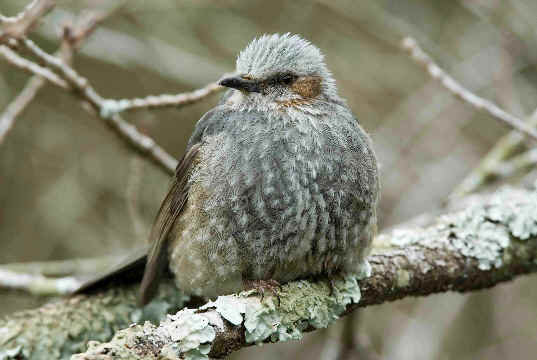
Brown-eared
Bulbul, photographed during the FONT
January/February 2009 Tour in Japan
(photo by Karl Frafjord, of Norway)

Olive-backed Pipit, photographed during the FONT
January/February 2009 Tour in Japan
(photo by Karl Frafjord, of Norway)
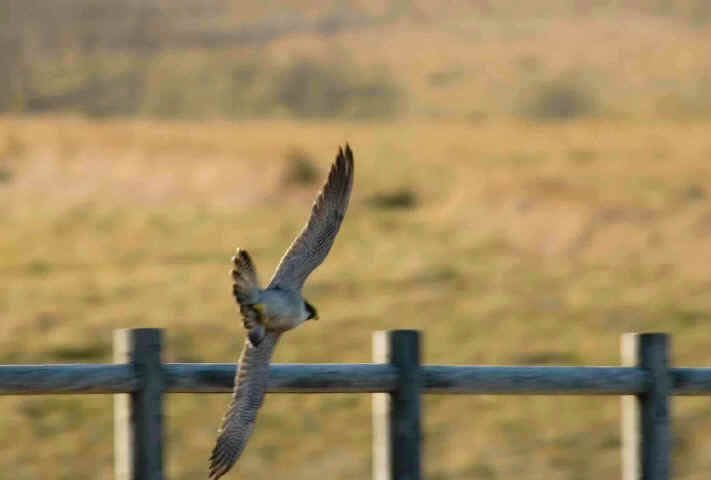
In February 2009, during our Japan tour,
when we were near some cliffs
along the southern coast of Hokkaido,
2 Peregrine Falcons were hunting in unison.
They were going in fast flight after a Dusky Thrush.
When one of the Peregrines flew by us quickly,
to our eyes its was but a blur.
But, as shown above, to the eye of the camera,
its image was clear.
(photo by Karl Frafjord, of Norway)
![]()
Northern
Mexico (in Sonora)
& Southern Arizona - January 2009
The first part of this wonderful tour
was in the Mexican state of Sonora, where we saw hundreds
(actually thousands)
of birds of various sorts along the coast of the Sea of Cortez
(also called the
Gulf of California), and where in the rugged hilly interior of the state, some
of the "good birds" were 2 with the same adjective, the Elegant Quail
and the Elegant Trogon, in addition to the Black-capped Gnatcatcher, Bendire's Thrasher,
Streak-backed Oriole, and the largest of the
subspecies of the Wild Turkey, known as the "Gould's Turkey".
During the second part of the tour, in southern Arizona, we saw thousands of
Sandhill Cranes, and numerous Hawks of a variety of species, including the
Ferruginous, Rough-legged, Harris's, and various morphs of the Red-tailed.
It was a great tour for January (the weather was superb!), and a first for us at
that time of year.
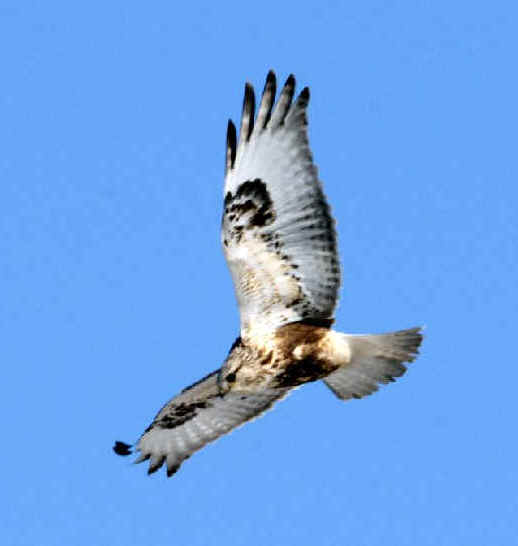
A hovering light-morph
Rough-legged Hawk,
as seen during our Jan 2009 tour in Arizona.
(photo by Howard Eskin)
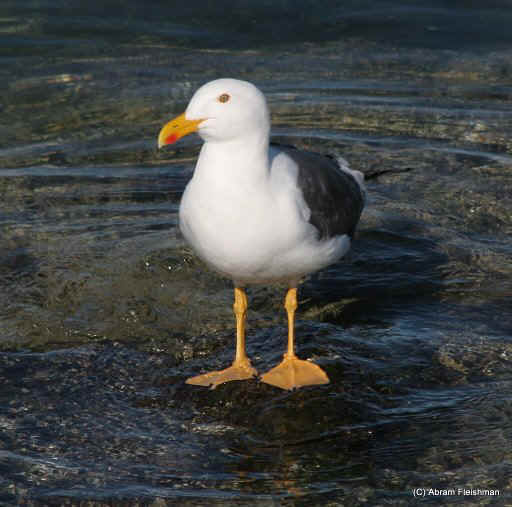
A Yellow-footed Gull.
We saw hundreds of these birds during
our January 2009 FONT tour in Sonora, Mexico
along the coast of the Sea of Cortez.
(photo by Abram Fleishman)
Links:
Birds
& Other Wildlife during our southern Arizona & northern Mexico Tour in January
2009
Birds of Arizona
(part 1: Quails to Becard) (with photos)
Birds of Arizona (part 2: Flycatchers to Buntings) (with photos)
Birds of Mexico (part 1: Tinamous to Shorebirds) (with photos)
Birds of Mexico (part 2: Jaegers to Woodpeckers) (with photos)
Birds of Mexico (part 3: Manakins to Buntings) (with photos)
Mammals of Arizona (with photos)
Mammals
of Mexico (with photos)
Upcoming FONT Birding & Nature Tours in Arizona
Upcoming
FONT Birding & Nature Tours in Mexico
![]()
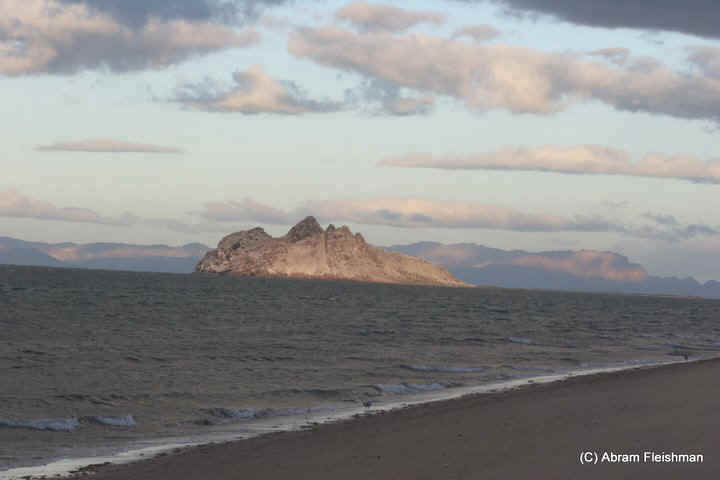
Above: The island called Alcatraz (or
"Pelican")
that we visited when we went to the Sea of Cortez
during our January 2009 tour in Sonora, Mexico.
Below: The race of the Brown Pelican that occurs
at that island is Pelecanus occidentalis californicus,
which has a bright red gular pouch in breeding plumage.
(photos by Abram Fleishman)
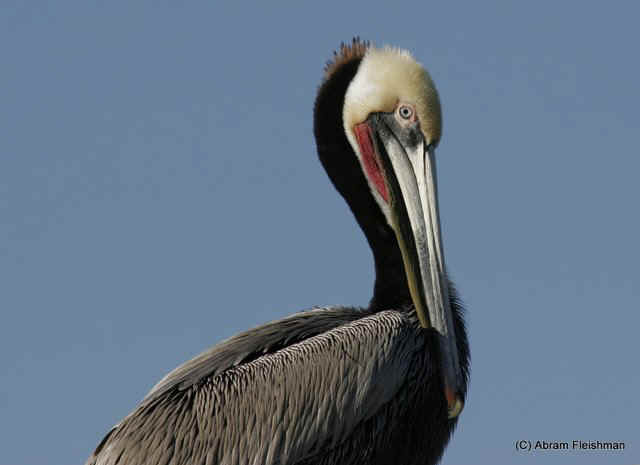
![]()
Guatemala
- December 2008/January 2009
During this tour, our
15th in Guatemala, as many as 316 species of birds were found throughout a country
with a variety of habitats and some most spectacular scenery. Highlights
among the birds included: Pheasant Cuckoos, Orange-breasted Falcons, and
Ocellated Turkeys near the Mayan ruins at Tikal,
5 species of kingfishers during
one river-boat ride in the Peten in addition to
Sungrebe and Boat-billed Herons,
while in the mountains our birds included: looks at both Ferruginous and
Mountain Pygmy-Owls, Chestnut-sided Shrike-Vireo, Blue-and-white Mockingbird, Black-throated and
Bushy-crested Jays, Hooded Grosbeak, Pink-headed Warbler, and the dapper Prevost's Ground
Sparrow.
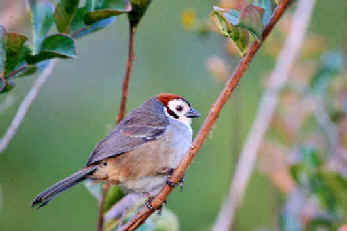
Prevost's Ground Sparrow
(photo by Marie Gardner)
And there were more than birds, as would normally be the case during a tour in
the Neotropics. But what was not expected was to be another tour with ANOTHER
JAGUAR, following our previous tour a couple months earlier just to the north in
southern Mexico when that large, wild cat was also encountered. During the Dec
08/Jan 09 Guatemala tour, the Jaguar was at Tikal at night, where it roamed just
outside our rooms. The roar of the animal was heard 3 times there during one of
the nights of our stay.
Other animals during the tour included: both Yucatan Howler and Central American
Spider Monkeys, White-nosed Coatis, Central American Agoutis, and
White-tailed Deer. We saw all of them during the day not far from where the
roaring Jaguar wandered about at night.
In the mountains, in darkness before dawn, a sound that we heard was that of the
animal called the Cacomistle (a raccoon-like creature).
In darkness, after one fine day of our tour, we saw in the distance a red glow
in the sky and a red flow on the slope of a high volcano - another
notable experience during our week-plus Guatemala "festive, holiday
tour".
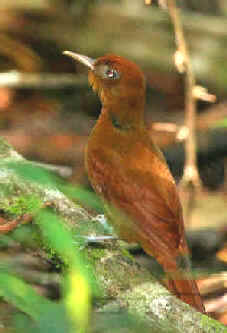
The Ruddy Woodcreeper
was one of over 300 species of birds
during our FONT Guatemala tour in Dec '08/Jan '09.
Photos of some others seen during the tour follow.
(above photo by Marie Gardner)
Links:
Lists of Birds & Other Wildlife during our Guatemala Tour in December 2008 / January 2009
Cumulative List of Birds during FONT tours in Guatemala
Upcoming FONT Birding & Nature Tours in Central America
The following set of photos are just a few of the 317 species of birds that were
found during the FONT Holiday tour in Guatemala in Dec/Jan 2008-09. (These
photos by Dick Tipton.)
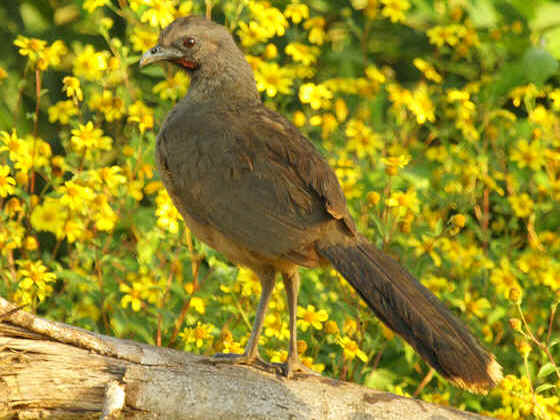
Plain Chachalaca
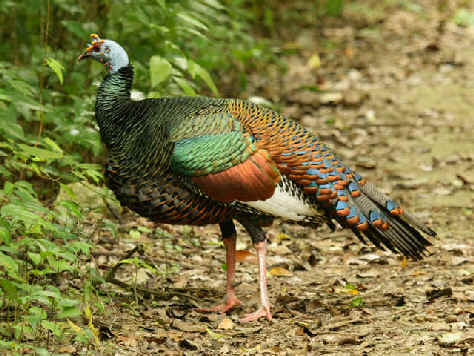
Ocellated Turkey
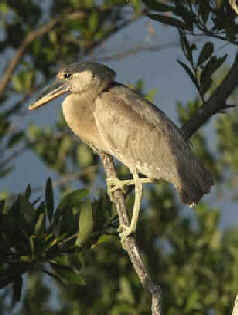
Boat-billed Heron

Squirrel Cuckoo
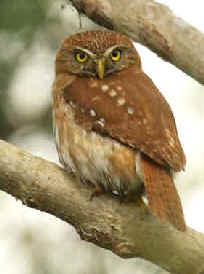
Ferruginous Pygmy-Owl
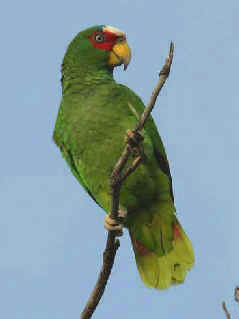
White-fronted Amazon